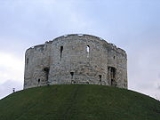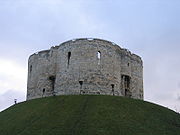
Yom Tov of Joigny
Encyclopedia
Yom Tov of Joigny, also denoted of York (died 1190) was a French
-born rabbi
and liturgical poet
of the medieval era who lived in York
, and died in the massacre of the Jews of York in 1190. A Hebrew language hymn
attributed to him, transliterated "Omnam Kayn" or "Omnam Ken" (Heb: "indeed thus") is still recited in all Ashkenazi synagogues each year on the evening of Yom Kippur
, the Day of Atonement. He was a student of Rabbenu Tam.
 At York
At York
on the night of 16 March 1190, (the day of the Jewish feast of Shabbat ha-Gadol, the shabbat
before Passover
, 17 March 1190), the Jews of York sought refuge in the Castle of York from a mob. The mob was led by Richard de Malbis (Richard Malebisse). When a fire broke out in the city of York, de Malbis used the opportunity to incite a mob to attack the home of Benedict of York, the recently deceased agent of Aaron of Lincoln
, to whom de Malbis was believed heavily in debt, killing his widow and children and burning the house. Josce of York
(Joseph), the leader of the Jewish community of York, obtained the permission of the warden of York Castle to remove his wife and children and the rest of the Jews into the castle, where they probably took refuge in a tower that stood where Clifford's Tower now stands. The Jews were also alarmed by massacres of other Jewish communities in the preceding weeks, in the wake of religious fervor during preparations for the Third Crusade
against the Saracens, led by Richard I of England
. However, the tower was besieged
by a mob, demanding that the Jews convert
to Christianity and be baptized
.
Trapped in the castle, the Jews were advised by Rabbi Yom Tov of Joigny to kill themselves rather than convert; Josce began by slaying his wife Anna and his two children, and then was killed by Yom Tov. The father of each family killed his wife and children, and then Yom Tov stabbed the men before killing himself. The handful of Jews who did not kill themselves surrendered at daybreak on 17 March, leaving the castle on a promise that they would not be harmed; they were also killed. In the aftermath the wooden tower was burnt down.
France
The French Republic , The French Republic , The French Republic , (commonly known as France , is a unitary semi-presidential republic in Western Europe with several overseas territories and islands located on other continents and in the Indian, Pacific, and Atlantic oceans. Metropolitan France...
-born rabbi
Rabbi
In Judaism, a rabbi is a teacher of Torah. This title derives from the Hebrew word רבי , meaning "My Master" , which is the way a student would address a master of Torah...
and liturgical poet
Poet
A poet is a person who writes poetry. A poet's work can be literal, meaning that his work is derived from a specific event, or metaphorical, meaning that his work can take on many meanings and forms. Poets have existed since antiquity, in nearly all languages, and have produced works that vary...
of the medieval era who lived in York
York
York is a walled city, situated at the confluence of the Rivers Ouse and Foss in North Yorkshire, England. The city has a rich heritage and has provided the backdrop to major political events throughout much of its two millennia of existence...
, and died in the massacre of the Jews of York in 1190. A Hebrew language hymn
Hymn
A hymn is a type of song, usually religious, specifically written for the purpose of praise, adoration or prayer, and typically addressed to a deity or deities, or to a prominent figure or personification...
attributed to him, transliterated "Omnam Kayn" or "Omnam Ken" (Heb: "indeed thus") is still recited in all Ashkenazi synagogues each year on the evening of Yom Kippur
Yom Kippur
Yom Kippur , also known as Day of Atonement, is the holiest and most solemn day of the year for the Jews. Its central themes are atonement and repentance. Jews traditionally observe this holy day with a 25-hour period of fasting and intensive prayer, often spending most of the day in synagogue...
, the Day of Atonement. He was a student of Rabbenu Tam.

York
York is a walled city, situated at the confluence of the Rivers Ouse and Foss in North Yorkshire, England. The city has a rich heritage and has provided the backdrop to major political events throughout much of its two millennia of existence...
on the night of 16 March 1190, (the day of the Jewish feast of Shabbat ha-Gadol, the shabbat
Shabbat
Shabbat is the seventh day of the Jewish week and a day of rest in Judaism. Shabbat is observed from a few minutes before sunset on Friday evening until a few minutes after when one would expect to be able to see three stars in the sky on Saturday night. The exact times, therefore, differ from...
before Passover
Passover
Passover is a Jewish holiday and festival. It commemorates the story of the Exodus, in which the ancient Israelites were freed from slavery in Egypt...
, 17 March 1190), the Jews of York sought refuge in the Castle of York from a mob. The mob was led by Richard de Malbis (Richard Malebisse). When a fire broke out in the city of York, de Malbis used the opportunity to incite a mob to attack the home of Benedict of York, the recently deceased agent of Aaron of Lincoln
Aaron of Lincoln
Aaron of Lincoln was an English Jewish financier . He is believed to have been the wealthiest man in 12th century Britain; it is estimated that his wealth exceeded that of the King. He is first mentioned in the English pipe-roll of 1166 as creditor of King Henry II for sums amounting to £616 12s...
, to whom de Malbis was believed heavily in debt, killing his widow and children and burning the house. Josce of York
Josce of York
Josce of York was the leader of the Jewish community in York, England, and the leading figure in the York massacre of 1190. He committed suicide along with nearly the entire Jewish community, rather than face death or conversion at the hands of an angry mob.Josce is mentioned in the earliest...
(Joseph), the leader of the Jewish community of York, obtained the permission of the warden of York Castle to remove his wife and children and the rest of the Jews into the castle, where they probably took refuge in a tower that stood where Clifford's Tower now stands. The Jews were also alarmed by massacres of other Jewish communities in the preceding weeks, in the wake of religious fervor during preparations for the Third Crusade
Third Crusade
The Third Crusade , also known as the Kings' Crusade, was an attempt by European leaders to reconquer the Holy Land from Saladin...
against the Saracens, led by Richard I of England
Richard I of England
Richard I was King of England from 6 July 1189 until his death. He also ruled as Duke of Normandy, Duke of Aquitaine, Duke of Gascony, Lord of Cyprus, Count of Anjou, Count of Maine, Count of Nantes, and Overlord of Brittany at various times during the same period...
. However, the tower was besieged
Siege
A siege is a military blockade of a city or fortress with the intent of conquering by attrition or assault. The term derives from sedere, Latin for "to sit". Generally speaking, siege warfare is a form of constant, low intensity conflict characterized by one party holding a strong, static...
by a mob, demanding that the Jews convert
Forced conversion
A forced conversion is the religious conversion or acceptance of a philosophy against the will of the subject, often with the threatened consequence of earthly penalties or harm. These consequences range from job loss and social isolation to incarceration, torture or death...
to Christianity and be baptized
Baptism
In Christianity, baptism is for the majority the rite of admission , almost invariably with the use of water, into the Christian Church generally and also membership of a particular church tradition...
.
Trapped in the castle, the Jews were advised by Rabbi Yom Tov of Joigny to kill themselves rather than convert; Josce began by slaying his wife Anna and his two children, and then was killed by Yom Tov. The father of each family killed his wife and children, and then Yom Tov stabbed the men before killing himself. The handful of Jews who did not kill themselves surrendered at daybreak on 17 March, leaving the castle on a promise that they would not be harmed; they were also killed. In the aftermath the wooden tower was burnt down.
Further reading
- Encyclopaedia Judaica, articles Omnam Kayn and Yom Tov of Joigny
- Macy Nulman, The Encyclopedia of Jewish Prayer, article Omnam Kayn
- Service of the Synagogue: Day of Atonement, Part 1 Evening Service; pub. Routledge & Kegan Paul Ltd., p.38

